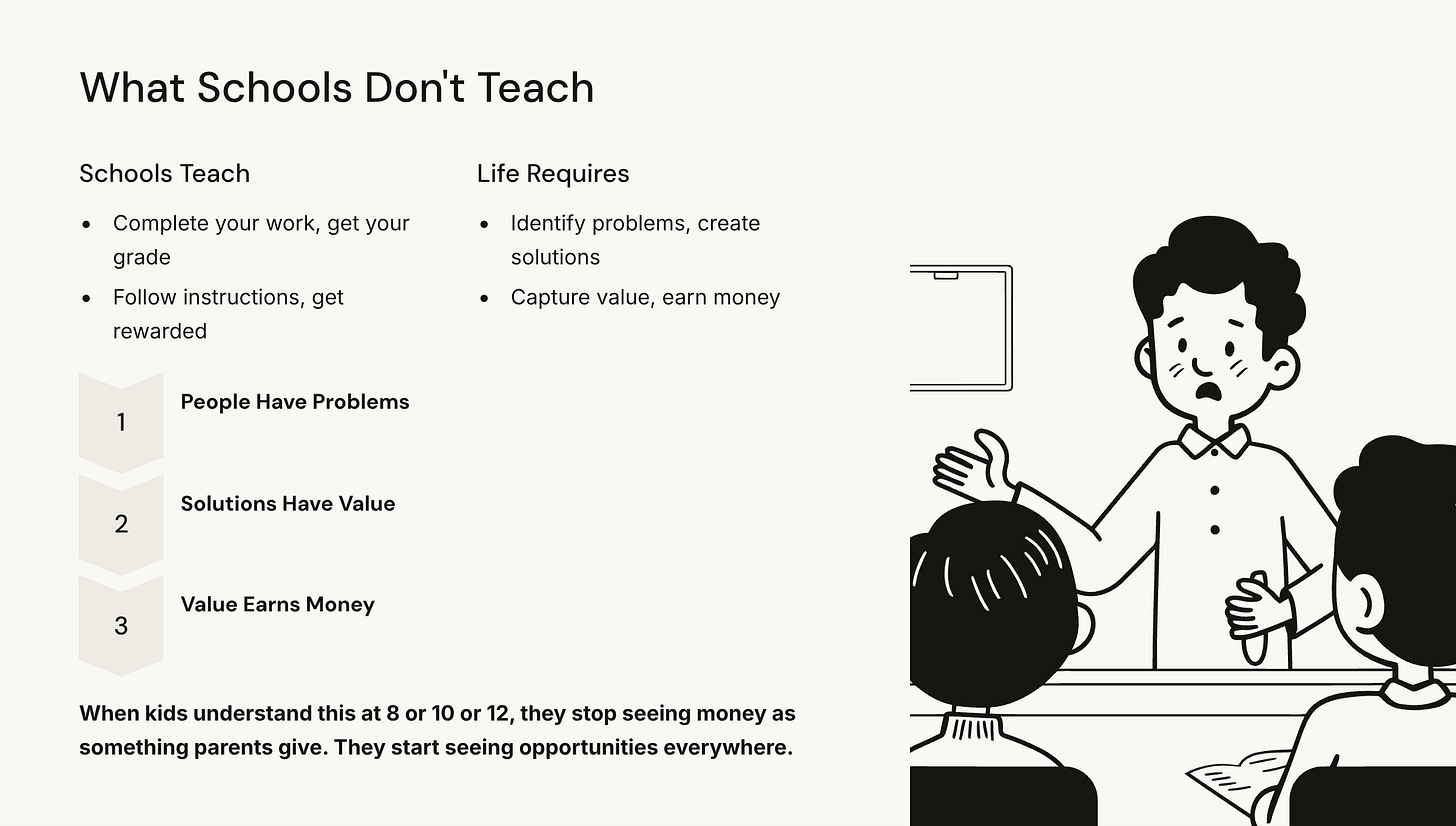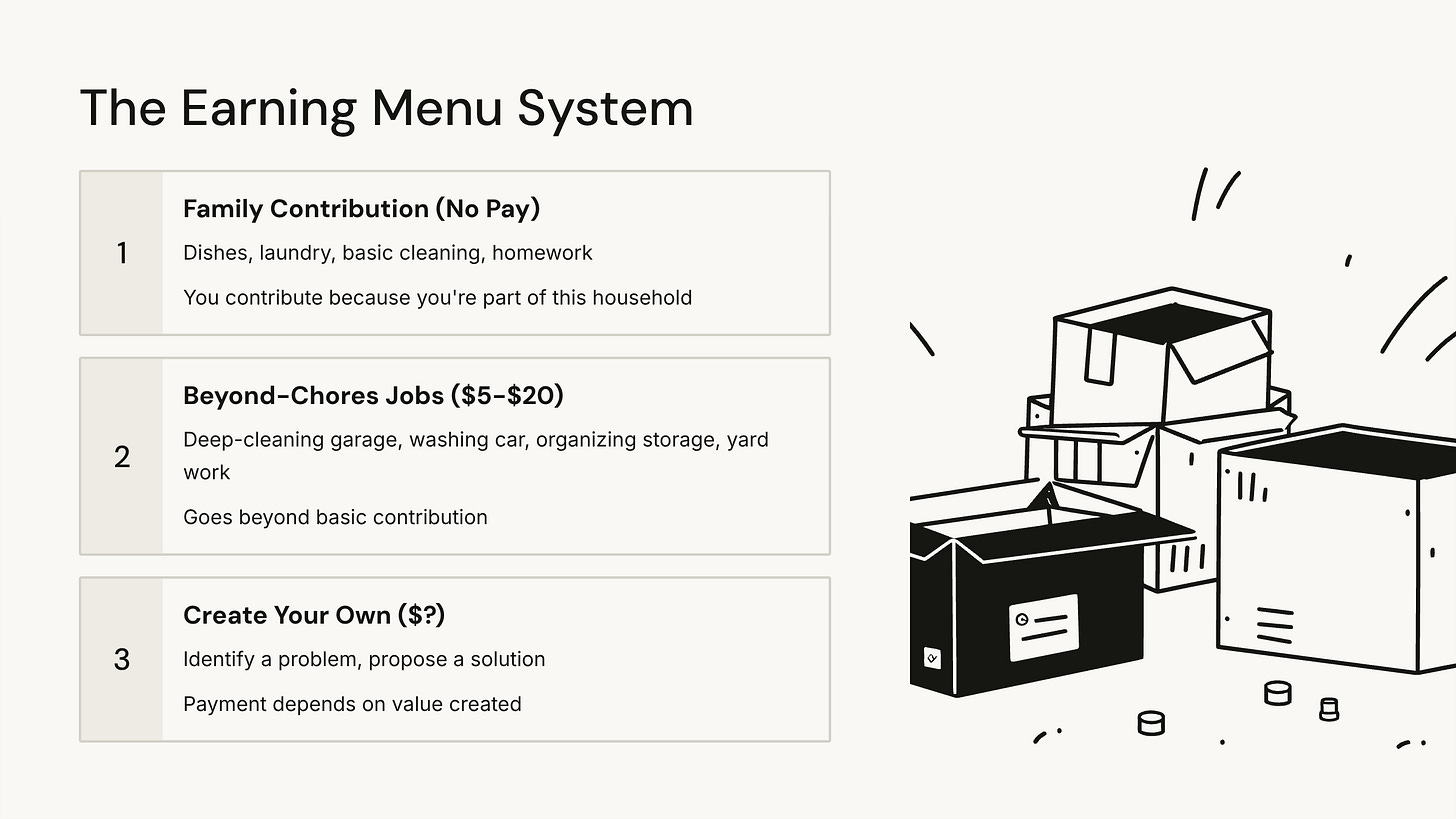When Your Kid Asks “Can I Earn More Money?”
My 12-year-old walked into the kitchen last Saturday morning with his laptop and a notepad.
“Dad, I need $85 for the new game everyone’s playing. My Save Jar has $47. If I keep saving my allowance, it’ll take 5 more weeks.”
I waited.
“Can I earn extra money somehow?”
That question. That’s the moment.
Not “Can you buy it for me?” Not “Can I get more allowance?” But “Can I earn more?”
The Four Jars System taught him money is finite. Now he’d hit the next realization: If I want more, I need to create more.
Schools teach kids to be good employees—follow instructions, complete assignments, get rewarded. But nobody teaches them to be problem solvers who create value and get paid for it.
That’s what we’re fixing this week.
The Problem: Allowance Isn’t Enough (And That’s Good)
Here’s what happens 3-4 weeks after you start the Four Jars System:
Your kid wants something bigger than their allowance can handle. A $60 LEGO set. Concert tickets. A new bike.
Most parents do one of three things:
- Give them the money (”You’ve been so good!”)—which destroys everything the jars taught
- Say no (”Sorry, too expensive”)—which feels like a dead end
- Raise the allowance—which teaches them to negotiate, not create
All three responses miss the teaching moment.
Because the real world doesn’t work that way. When adults want more money, we don’t ask for raises every time we want something. We find ways to create value and get paid for it.
That’s what kids need to learn next: earning beyond allowance.

What Schools Don’t Teach About Money
Schools teach: Complete your work, get your grade.
Life requires: Identify a problem, create a solution, capture value.
My son’s $85 gaming problem? Schools would say “save longer” or “that’s too expensive.”
But the real lesson is different: What could you do this week that someone would pay for?
This isn’t about child labor or entrepreneurship pressure. It’s about connecting three dots:
People have problems → Solutions have value → Value earns money
When kids understand this at 8 or 10 or 12, they stop seeing money as something parents give or withhold. They start seeing opportunities everywhere.
The neighbor’s leaves need raking. Grandma needs help organizing photos. The family down the street goes out of town and needs pet care.
Problems are everywhere. Solutions earn money.

The Earning Menu: How Our Family Does It
After my son asked about earning extra, I pulled out what we call the Earning Menu.
It’s a simple list divided into three categories:
Family Contribution (No Pay) These are things everyone does because we’re a family: dishes, laundry, basic room cleaning, homework. Non-negotiable, no payment. You contribute because you’re part of this household.
Beyond-Chores Jobs ($5-$20) These are things that genuinely help the household but go beyond basic contribution: deep-cleaning the garage, washing the car, organizing the storage room, yard work that takes real time.
Create Your Own ($?) This is where magic happens. Kids identify a problem someone has and propose a solution. Payment depends on the value created.

My son’s first “Create Your Own” project? He noticed our neighbor’s trash bins were always still on the curb Tuesday afternoons—the guy travels for work Mondays and Tuesdays. My son knocked on his door: “I could take your bins out Sunday night and bring them back Tuesday after school for $5 a week.”
The neighbor said yes immediately. “I’ve been getting complaints from the city council about leaving them out. You’re solving a real problem for me.”
Twenty weeks later, my son has earned $100 from trash bins. Simple quick service. Real value. Consistent money..
But here’s what really changed: He started seeing problems differently.
Now when we’re out, he notices things. “That person’s dog looks hard to control—I bet they’d pay for dog walking.” “Grandma always talks about organizing her closet—I could help her.”
He’s not looking for handouts. He’s looking for opportunities.
What Happened When Three Families Tried This
The Nguyens (kids 7 and 10): Their 10-year-old wanted new basketball shoes. Started a “Friday Filing” service for their dad’s home office—organizing papers every Friday for $8. Took a month, bought the shoes, kept the job going.
The 7-year-old couldn’t do complex jobs yet, but she started a “Room Reset Service” for her brother—making his bed and organizing his toys before Mom’s Saturday inspection for $3. He gladly paid to avoid the chore.
The Martinez Family (kids 9 and 12): The 12-year-old created a “Tech Help” menu for extended family: setting up new phones, teaching Grandpa video calls, organizing Google Photos. Charged $10-$20 depending on complexity. Earned $120 in six weeks.
The 9-year-old started a Saturday morning “Breakfast Service” for the family—full breakfast cooked and cleaned up for $5. Parents paid happily because they got to sleep in.
The Wilson Family (kids 8, 10, and 14): They did something brilliant. Every Sunday night, they have “Problems & Solutions Time.” Each family member shares one problem they noticed during the week. Kids propose solutions—some earn money, some don’t, but all practice problem-solving.
Their 8-year-old noticed the downstairs bathroom always needed restocking. Started a “Bathroom Butler” weekly service for $4.
The pattern? Once kids understand earning, they become problem solvers.
Author
Jim – A parent of two beautiful children






LEAVE A COMMENT